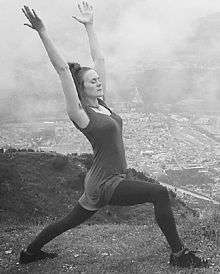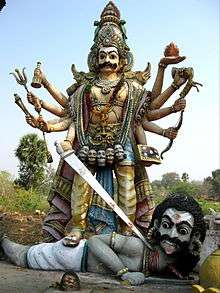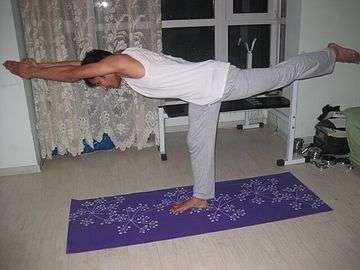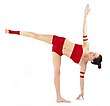Virabhadrasana
Virabhadrasana (Sanskrit: वीरभद्रासन; IAST: Vīrabhadrāsana) or Warrior Pose[1] is a group of related lunging standing asanas in modern yoga as exercise commemorating the exploits of a mythical warrior, Virabhadra.

Etymology and origins
The name is from the Sanskrit वीरभद्रासन Virabhadrāsana, the asana of the mythical warrior Virabhadra. The warrior's name is in turn from the Sanskrit वीर Vira "hero" and भद्र Bhadra "friend".[2] Ancient cave rock sculptures in the Ellora Caves, specifically cave 16[3] and cave 29,[4] show a warrior-Shiva figure in a pose somewhat resembling Virabhadrāsana while conquering demons or wooing his consort Parvati.[5] Still, these poses are not attested in the hatha yoga tradition until the 20th century with the practices of Tirumalai Krishnamacharya and his student Pattabhi Jois, who was photographed in Warrior I in about 1939.[6]
Poses close to Virabhadrasana were described independently of yoga in a European source early in the 20th century, namely in Niels Bukh's 1924 Danish text Grundgymnastik eller primitiv gymnastik (known in English as Primary Gymnastics).[7] Bukh's poses were derived from a 19th century Scandinavian tradition of gymnastics dating back to Pehr Ling, and "found their way to India" by the early 20th century.[7] Mark Singleton suggests that these standing poses were most likely influenced by the tradition of physical culture including Bukh-style gymnastics of the early 20th century.[8]
Mythology

The myth is that the powerful priest Daksha made a great yagna (ritual sacrifice) but did not invite his youngest daughter Sati and her husband Shiva, the supreme ruler of the universe. Sati found out and decided to go alone to the yagna. When she arrived, Sati entered into an argument with her father. Unable to withstand his insults, she spoke a vow to her father, "Since it was you who gave me this body, I no longer wish to be associated with it." She walked to the fire and threw herself in. When Shiva heard of Sati's death, he was devastated. He yanked out a lock of his hair and beat it into the ground, where up rose a powerful Warrior. Shiva named this warrior Virabhadra and ordered him to go to the yagna and destroy Daksha and all his guests.[9]
- Virabhadra's first aspect, Vīrabhadrāsana I, is his arrival, with swords in both hands, thrusting his way up through the earth from below.[9]
- In his second aspect, Vīrabhadrāsana II, he sights his opponent, Daksha.[9]
- And in his third aspect, Vīrabhadrāsana III, moving swiftly and precisely, he decapitates Daksha with his sword.[9]
Shiva then arrives at the yagna and sees the rout that Virabhadra had wrought. Shiva absorbs Virabhadra back into his own form and then transforms into Hara, the ravisher. Filled with sorrow and compassion, Shiva finds Daksha's body and gives it the head of a goat, which brings him back to life. In the end Sati is also reborn.[9]
Description
The poses can be entered from a standing position, Tāḍāsana, jumping or stepping the feet wide apart. For Virabhadrāsana I, the hips are turned to face the front foot, which is turned fully outwards; the back foot is turned halfway inwards. The body sinks down into a lunge until the front knee is bent to a right angle, the back leg remaining straight, and the back foot working to keep the whole of the sole of the foot on the floor. The arms are stretched straight upwards, the back is slightly arched, and the gaze is directed upwards.[2][10]
For Virabhadrāsana II, starting from Tāḍāsana, the feet are spread wide, the front foot is turned fully out, and the back foot is turned in very slightly. The body remains facing forwards, so the hips remain in line with the feet, the body sinks down into a lunge until the front knee is bent at a right angle, and the arms are extended fully with the palms down, at shoulder level. The gaze is directed straight forward over the front hand.[2][11][10]
For Virabhadrāsana III, a more difficult pose requiring strength and balance, again starting from Tāḍāsana, the feet are arranged as for Virabhadrāsana I. The trunk is turned fully to face the front foot, with the arms extended straight forwards, the gaze straight forwards, the trunk horizontal and one leg stretched back and also horizontal.[12][11][13]
It is possible to enter Vīrabhadrāsana using vinyasas starting from Adho Mukha Śvānāsana[14] or from Tadāsana.[15]
.jpg) Virabhadrasana II
Virabhadrasana II Virabhadrasana III
Virabhadrasana III Reverse Warrior Pose, Viparita Vīrabhadrasana, a modern variant of Virabhadrasana II[16]
Reverse Warrior Pose, Viparita Vīrabhadrasana, a modern variant of Virabhadrasana II[16]
Variations
Viparita Virabhadrasana, Reverse Warrior Pose (Sanskrit विपरीत viparīta, "reversed"[17][18]), is a variant of Virabhadrasana II, with the upper body and forward arm tilted backwards. The lower arm may be stretched down the rear leg, or it may reach round the back to the opposite hip. The pose is not found in Light on Yoga and may have been created as recently as the start of the 21st century.[16][19]
In culture
Virabhadrāsana has been called "easily one of the most iconic and recognizable postures" in yoga.[20]
See also
Citations
- YJ Editors (12 April 2017). "Warrior I Pose". Yoga Journal.
- Iyengar 1979, pp. 69-74.
- cave 16
- cave 29
- Dhavalikar, Madhukar Keshav (2005). Ellora. New Delhi: Oxford University Press. pp. 49, 83. ISBN 0-19-567389-1. OCLC 57431189.
- "Virabhadrasana or Warrior Pose". Bahiranga.com. Retrieved 11 January 2019.
- Singleton, Mark (4 February 2011). "The Ancient & Modern Roots of Yoga". Yoga Journal. which makes use of Bukh, Niels (1924). Grundgymnastik eller primitiv Gymnastik [Primary Gymnastics] (in Danish). Copenhagen: Hagerup. OCLC 467899046.
- Singleton, Mark (2010). Yoga Body: The Origins of Modern Posture Practice. Oxford University Press. p. 161. ISBN 978-0-19-539534-1. OCLC 318191988.
- Iyengar 1979, pp. 69-70.
- Mehta 1990, pp. 26-29.
- Lidell 1983, p. 150.
- Iyengar 1979, pp. 69–74.
- Mehta 1990, pp. 32–33.
- Hughes, Aimee. "Sun Salutation A Versus Sun Salutation B: The Difference You Should Know". Yogapedia.
- "Virabhadrasana I (Warrior Pose 1) Tutorial". Vinyasa Yoga School. Retrieved 23 July 2019.
- McCrary, Meagan (15 July 2015). "#YJ40: 10 Poses Younger Than Yoga Journal". Yoga Journal.
Reverse Warrior You won’t find this playful variation of Warrior II Pose in Light on Yoga.
- "Reverse Warrior Pose - Viparita Virabhadrasana". Gaia.
- "Reverse Warrior".
- Kaivalya, Alanna (28 April 2012). "How We Got Here: Where Yoga Poses Come From". Huffington Post. Retrieved 2 December 2018.
- Helbert, Karla (2015). Yoga for Grief and Loss: Poses, Meditation, Devotion, Self-Reflection, Selfless Acts, Ritual. Jessica Kingsley. p. 254. ISBN 978-0-85701-163-3.
General sources
- Iyengar, B. K. S. (1979) [1966]. Light on Yoga: Yoga Dipika. Unwin Paperbacks.CS1 maint: ref=harv (link)
- Lidell, Lucy, The Sivananda Yoga Centre (1983). The Book of Yoga. Ebury. ISBN 978-0-85223-297-2. OCLC 12457963.CS1 maint: ref=harv (link)
- Mehta, Silva; Mehta, Mira; Mehta, Shyam (1990). Yoga: The Iyengar Way. Dorling Kindersley.CS1 maint: ref=harv (link)
_from_Jogapradipika_1830_(detail).jpg)
